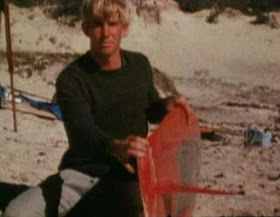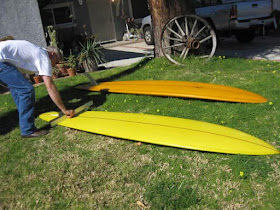The hull/trimming approach to surfing opens up "style" to virtually any body type.
Take the case of one James "Chubby" Mitchell. Reportedly somewhere around 5'9'' x 300 lbs, he was poetry in motion on an 11 foot, D-fin longboard. Good luck to anyone with those body-dims on a thruster!
1968
Tom Ornter -- who rode Windansea as well as anyone before or since -- at 3M's in Baja, 1968. This pic was one of the early salvos in the shortboard revolution in the US surf media.
From Orion
Paul,
I noticed you had posted my fave pic of the controversial Milius and had made my own poster a few years back of it after stumbling on the article that featured it in an early 80's surfer magazine.
I had wanted to recreate it for awhile and since The Surfer's Journal had recently approved an article on my artwork to be published in their pages...I thought it would be a good time to try to do it. My good friend photographer Kanoa Zimmerman came down to do some Cindy Sherman-esque portraits of me for the article. For some reason they decided to go with much safer standard portrait of me for the article. Who knows why? They aren't using it and I'd like the Hull community to see it. Here's the take from Kanoa and me. Hope you dig it.
Not really a rocket launcher type of guy myself...
-Orion
I noticed you had posted my fave pic of the controversial Milius and had made my own poster a few years back of it after stumbling on the article that featured it in an early 80's surfer magazine.
I had wanted to recreate it for awhile and since The Surfer's Journal had recently approved an article on my artwork to be published in their pages...I thought it would be a good time to try to do it. My good friend photographer Kanoa Zimmerman came down to do some Cindy Sherman-esque portraits of me for the article. For some reason they decided to go with much safer standard portrait of me for the article. Who knows why? They aren't using it and I'd like the Hull community to see it. Here's the take from Kanoa and me. Hope you dig it.
Not really a rocket launcher type of guy myself...
-Orion
Old Yeller Followup
Putting on the breaks on Old Yeller. Just 4 out that day...me, the 2 dolphins and the kneeboarder.
Often imitated, never duplicated! Definitely one of those magic boards.
It was my board during El Niño '97. The thing ripped from 2' on up to the biggest swells of that epoch.
KP took it back before I rode it to death. Good thing he did, because it needed to be preserved-just a radical, screaming ass board! In my top 3 for sure!
Matt Miller
Bike Flex
Frame flex testers comparing notes in the field.
It might seem a little off topic, but this expose' on bike flex relates directly to mats and surfboards. It deals with the myth that's grown over recent years that the stiffer a bike frame is, the faster it will go. That concept follows a logical thought pattern: The stiffer the frame is, the more power is transferred from the rider as he or she peddles. Flex, the notion goes, absorbs energy and robs the rider of forward motion. In professional bike racing, even the slightest disadvantage is a major liability, so high end bikes have gotten stiffer and stiffer to address that belief. Perhaps in vain, as it turns out.
This article goes into a pretty detailed study of bike flex, and how, if properly applied, it can actually add to the speed of the rider. The conclusion isn't that flexy bikes are faster, but that the right amount of flex relative to the rider will indeed generate more speed. As to why, it's best to read the article.
From the experience of mat surfers and hull riders, it was established decades ago that a properly flexible surfboard will go faster. Greenough's first flex fin was built in 1962, and his first flexible kneeboard in 1965...
The reason is flexible boards will conform to the wave face...if only slightly in the case of a stringerless board. A flexible board will naturally track into the most powerful part of the wave and absorb more energy.
In the case of surfmats, the reasons for lower inflation levels going faster are more difficult to verbalize. In fact, nothing short of comparing a mat that's fully inflated and a mat that's partially inflated will convince anyone of that fact.
Add to that, mat inflation levels that are too low will cause the mat so slide out and thus lose all of its speed. So, like bike frame flex, hitting the sweet spot is key. Unlike a finished bike frame, however, a mat's flex (via inflation level) can be changed from minute to minute.
Anyway, if you have a few minutes, the article is a good read...
Old Yeller
This is a board I shaped and glassed for the late Tom Cimino in the mid '80s. It was dedicated to larger Malibu. To that end, it had fairly flat rocker numbers, a sharply rolled bottom, dome deck, and thin rails.
As I recall, it was 8'10'' x 21 1/2". A tapered foil outline, roundtail.
Kirk Putnam has this board in his garage, so he might be able to provide some more specs.
Along side it, in the top two photos, is an Andreini of similar intent. KP and Roger Kelly are your presenters.
From The Office Of Mr. Milius
2 nuclear holocaust posters?
Check.
Fully functioning rocket launcher?
Check.
Surf leash?
Check.
Liddle hull?
WTF ???
Two Rick Classics
This is a 9'6'' Rick UFO model from 1966/67. It was, in some ways, a caricature of the trend towards step-decks...which started with the Yater Spoon in the summer of 1965. Like several other radical models in the mid-60's, the UFO featured a step tail as well as a step deck.
It also had a glass-on fin that was pretty sophisticated for the era...it had elements of both the narrower Greenough-inspired flex fins, and the nose-rider tip-bulb fins.
---------------------------------------------------------------------------
Both boards had glass-on fins, during the hey day of the WAVE Fin System era.
Old PG Hull
-------------------------------------------------------------------------
I shaped this board in the early 80's from three inspirations...
Skip Frye built an egg for Gary Keating in the early 70's that was so thin, you could flex it by pushing down on the deck with your hand when it was sitting on the floor with a fin in it. Just amazing. Around 6'6'', as I recall.
Another incredibly thin, 70's era board was a hull shaped by Tim Bowler that he called "The Bottom Half." The deck was completely shaved off of it.
The third one was a bladed-out 6'8'' Dirt Machine Greg Liddle built for Steve K. It took a little bit of a wave for it to get going, but once it broke free, it went like a rocket.
So with those were the boards I had in mind when I shaped this one. I wanted minimum thickness still retaining a little bit of S in the deck. I think I used 4 oz cloth.
It ended up being a good board in clean surf head high or better...









































